
Image via Wikipedia
Mars has been a mystery from a longtime ever since we have started to envision life thereon the Mars. Here is an excellent article from Markus Hotakainen, explaining the necessity of human exploration to Mars.
By Markus Hotakainen
1. Introduction
Until now Mars probes, orbital or vehicular, have been controlled by a combination of onboard software and radio communication with Earth-based humans. The main focus of interest has been the geological character of the planet (Levine et al., 2010a,b). However, there are many unexplained anomalies which are also deserving of attention and the close inspection of trained teams of astronauts.
The geological processes which characterize Mars are similar to and familiar from Earth (Levine 2010a,b). The principle of the past being the key to the present is applicable on the large scale. With a surface area similar to that of all the continents of Earth and a readily observable geological record of billions of years, Mars is a treasure-trove for planetary research, both of the planet itself, with relation to Earth, and in connection with the origin and evolution of the Solar System as a whole.
However, the exploration of Mars has to take into account the fact that during most of its evolution the conditions have been crucially different from those of the ancient and present-day Earth, which means similar processes could have led to different outcomes.Indeed, it is not just geology and biology, but the fact there are many unexplained Martian anomalies which require trained field scientists. For example, there is a wealth of enigmatic features on Mars defying any simple and straight-forward explanations. Many of these features will keep their secrets until human presence. Even the most sophisticated robotic probes with most advanced artificial intelligence lack – at least for the moment – the ingenuity and creativity of the human mind.
Thus the next step in the exploration of our planetary neighbor, should be a human mission to Mars and the landing a human crew, whose observations will certainly go beyond questions of geology but will also seek to determine whether life in any form exists on the planet today, or has existed in the past. Recent discoveries in the biological sciences have conclusively demonstrated that living organisms are capable of surviving in extreme conditions, and this means we cannot rule out the possibility that some form of organic life exists on Mars even in the conditions that prevail today. In terms of a search for evidence, there are a number of intriguing candidates for a landing site and base camp. Such sites would include proximity to water in the form of ice, which exists at the poles and also likely within the confines of some craters; all of which may harbor life.
Consequently exploring the anomalies of Mars could potentially give new insight into the geological and biological history of Mars and Earth. However, this would require human presence, as advocated by astronauts Dr. Edgar Mitchell (Mitchell & REF) and Dr. Harrison Schmitt (2010). Astronaut Schmitt is a trained geologist and the last man to step upon the surface of the Moon and he argues that it is imperative that field geologists accompany the first astronauts to Mars (Schmitt 2010). It is because of this astronaut geologist, and the human presence on the Moon, that the Apollo program contributed to many important discoveries giving clues to the birth and evolution of our cosmic companion.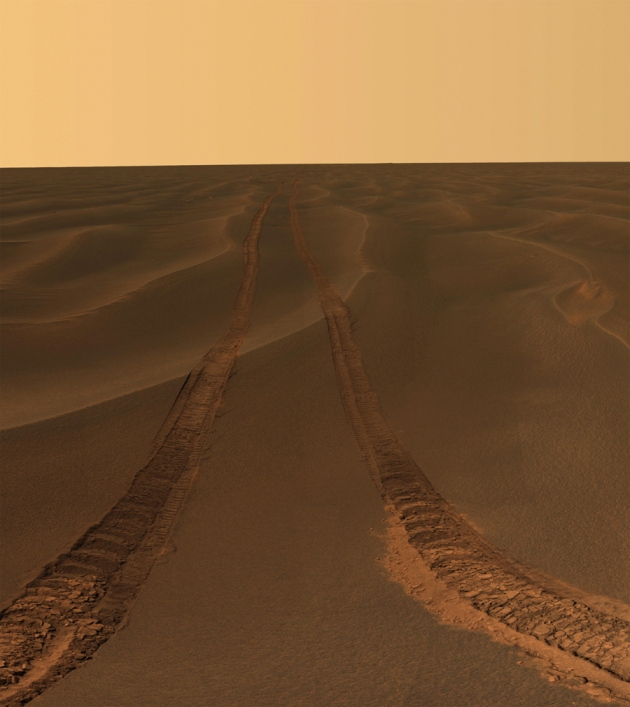
- Tracks to be followed. Robotic rovers – Sojourner, Opportunity, and Spirit – have paved a way to manned exploration of Mars. Credit: NASA/JPL/Cornell
2. Wet Mars
One of the most intriguing questions in the study of Mars has been and still is the existence of water. It is the most important substance making the difference as well as the similarity between Mars and Earth. The currently cold and arid Mars has experienced a period (or periods) of warmer and wetter climate with a considerably thicker atmosphere (Morris et al. 2010).
The images acquired with the high-resolution cameras of several probes launched during the past decade and a half – Mars Global Surveyor, Mars Odyssey, and Mars Reconnaissance Orbiter of NASA, and Mars Express of ESA – and the research conducted on the surface with the rovers – Sojourner, Opportunity, and Spirit – have proved that there has been water on the surface of Mars: lots of water (Carter et al. 2010; Di Achille 2010). And recent studies of the carbon and oxygen isotopes of the atmospheric CO2 suggests that there has been low-temperature interaction between water and rocks throughout the Martian history (Niles et al. 2010).
The surface of Mars is covered with different kinds of signatures of past water from narrow gullies on the walls of craters and slopes of hills and dunes through dried river beds and valleys carved by water to vast, smooth areas reminiscent of ocean floors. However, whether all of these formations are due to water (or ice) is still a matter of dispute, and other explanations like cryoclastic phenomena and gas-supported density flows have been brought forth (Hoffman 2000).
- On the pole-facing slopes of the dunes in Russell Crater on the southern hemisphere of Mars there are narrow gullies side by side. Credit: NASA/JPL/University of Arizona
In many cases the surface anomalies – just like the more ordinary features – are seemingly the result of flowing water or melting ice, coupled with perhaps tricks of light and shadow and the propensity of the human imagination to conjure forth not just what is, but what might be. However, dismissing these anomalies as illusions or to assume they are the result of natural geological forces, is not in the spirit of science. Assumptions, be they pro or con, are not the same as facts. Rather, these surface anomalies require serious consideration and investigation which in turn would lead to the advancement of science, and lead to a greater understanding of planetary geology and the cause and origins of these anomalies.
3. Martian Arctic Ocean
The most prominent anomaly of Mars is the dichotomy between the northern and southern hemispheres. The southern highlands are covered with craters of all sizes, the northern lowlands are exceptionally flat and smooth. There is also an average difference of 4 kilometers in their elevations (Kiefer, 2008).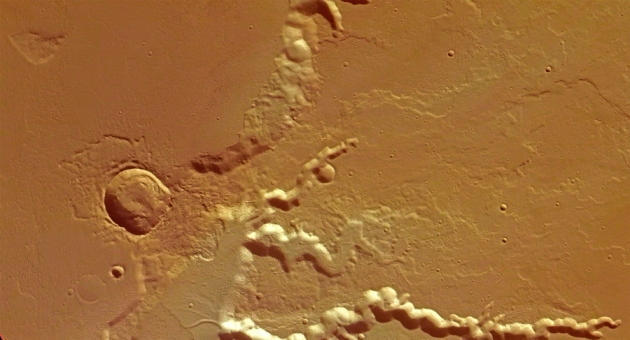
- The highland-lowland dichotomy boundary of Mars is at most places – like in this area near Medusa Fossae – very apparent. Credit: ESA/DLR/FU Berlin (G. Neukum)
One of the theories is that there had been a vast Martian ocean covering most of the northern hemisphere. An ocean of Martian water would explain the smoothness. However, if there had been a Northern ocean, then where are the ancient shorelines? Shorelines should be evident at the borderline between the highlands and the lowlands. Although many have claimed to have detected these palaeoshorelines (Parker et al. 1993), these claims are in most cases controversial to say the least. If there had been ancient oceans, perhaps the shorelines have disappeared after being blanketed by later sedimentation. Or perhaps the failure to find conclusive evidence is due to the insufficient resolution of the imaging instrumentation of the probes. Trained field observers, could provide the answers.
The existence of an ancient ocean is further implied by the distribution of ancient deltas dilineating the margins of the northern lowlands. The level of these deltas is consistent with the possible palaeoshorelines indicated by the analysis of other morphological and topographical features, as well as the distribution and age of valley networks on the surface of Mars (Di Achille 2010).
Also the recent detection of hydrated silicates in the northern plains indicates a past presence of large amounts of water. The silicates have been known to exist on the southern highlands implying wet conditions early in the history of Mars, but now the same goes with the northern highlands. The ancient deposits of these hydrated silicates, being mostly phyllosilicates, excavated at places by impact cratering, are covered with hundreds of metres of later sedimentation (Carter et al. 2010).
Perhaps the answers concerning the existence of the ancient ocean could be obtained by sophisticated high-resolution cameras and deep-range radars onboard an orbiting craft. However, these answers may not be obtained without in-situ exploration, including deep drilling, which would be difficult to accomplish without human presence.
Finding a landing site with the highest potential to give an answer to this question on the existence of an ancient sea might also prove difficult. The borderline between the highlands and lowlands is at many places a very steep slope making it unsuitable for landing a manned craft. However, there is an area with not only an appropriate location, but a wealth of enigmatic features.
4. Cydonian Complex
The first feature to arouse the interest of both the scientific community and the general public was the detection of a “face-like” anomaly in the area known as Cydonia, a plain in a transitional region between heavily cratered southern highlands and the smooth northern lowlands; the so called “Face of Mars”. It was photographed by the Viking 1 Orbiter in July 1976 while making detailed imaging for the selection of the landing site for the Viking 1 Lander.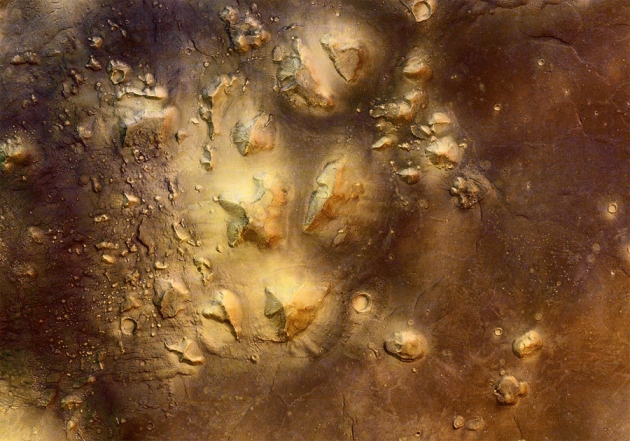
- The unusual mesas of the Cydonia region has led to wild speculation on their origin. The infamous “Face of Mars” is near the lower right-hand corner of this image. [Credit: Mars Express/ESA
The image of the “Face” gained immediately great publicity and a keen interest in, along with various speculations on, the origin of the familiar looking formation. There are strong advocates for the interpretation that this feature with a length of 2,5 kilometres and a height of 250 metres is artificial, being some kind of a vast monument or perhaps a cenotaph. Later images taken by various orbiters having instruments with higher resolution than those onboard Viking 1 has lent credence to the view of the Face being a natural formation, a rocky hill or mesa with crevices on top simulating the features of a giant face staring upward from the Martian surface.
The “Face of Mars” is not the only formation on the Cydonia plain having created both interest and controversy. Some of them have been seen as further evidence for the existence of an ancient, intelligent civilization on Mars. There are numerous formations reminiscent of eroded pyramids, ruined castles, and other structures claimed to have an artificial origin. However, the evidence for the artificiality of these formations, along with the “Face of Mars”, is not nearly conclusive enough, and the general view is that they are natural products of geologic processes. Nevertheless, the structural anomalies on the Cydonia plain are well worth a thorough investigation because of both their fame and the contribution their study would give to our knowledge on Mars and various processes shaping its surface – whatever the outcome.
The exploration of Cydonia would also give information on the nature of the borderline between the rugged south and smooth north. The area is possibly an ancient coastline with several processes having affected its evolution either concurrently or consecutively – or both. Landing a manned mission on the Cydonia plain would – in addition to the obvious impact on the imagination of the public and media – enable extensive studies of the ancient shoreline and its alterations. This could also shed light on the climate change which caused the transformation of a temperate planet into a frozen celestial object, a kind of “Museum of Water”. Situated on the mid-latitudes (40°N) Cydonia would also be an ideal target for the studies on the effects of the variability in the obliquity of the rotational axis of Mars.
At the moment the inclination is very close to that of Earth – 25°11’ of Mars compared with 23°59’ of Earth – but it has been known a long time that there is a variability of at least 20 degrees over a period of approximately 100 000 years (Ward 1973). However, the variability seems to be chaotic, and during periods of tens of millions of years the inclination could have changed several tens of degrees (Touma et al. 1993). Because of the chaotic nature of the variability it is impossible to track it precisely for more than a few million years into the past, but with statistical methods it is possible to analyze the history of these variations. The value for the maximum of the obliquity is 82°, and the probability for the obliquity having reached 60° during the past 1 billion years is 63 %, and during the past 3 billion years as high as 89 % (Laskar et al. 2004).
This kind of variation has had a dramatic effect on the climate of Mars in the past, and most probably is still having: the variability of the inclination is continuous. While the inclination is small and the planet rotates in an upright position, the polar areas receive much less solar energy than the lower latitudes, and are thus much colder. When the inclination increases, the poles receiving more solar energy warm up, but the equatorial regions cool down.
This variability is the probable cause for the presence of the large reservoirs of near-surface ice in high latitudes of both northern and southern hemispheres of Mars. While the obliquity is high, there is an accumulation of ice, most probably even in the form of glaciers, to the equatorial regions, but during low obliquity, the sublimation of these reservoirs results in deposition of ice to the high latitudes and polar regions (Levrard et al. 2004; Forget et al. 2006).
With a thicker atmosphere in the past this has affected the state of water and consecutively the sea level of the Arctic Ocean, but also the migration of water from the polar areas to the mid- and low- latitudes (Haberle et al., 2004). This in turn could be inferred from the current depth and thickness of permafrost present also beneath the surface of Cydonia.
5. Noctic Labyrinthus
Noctis Labyrinthus just south of the equator of Mars is a place of major upheaval – or “downfall” to be precise. It is an area of large mesas, broad and flat-topped mountains and hills with steep clifflike slopes, called “chaotic terrain”. According to early theories this chaotic terrain formed when large amounts of subsurface ice suddenly melted with the water flowing off (Carr and Schaber 1977) or groundwater being released from aquifers to create large outflows (Carr 1979), and the terrain collapsing as a result.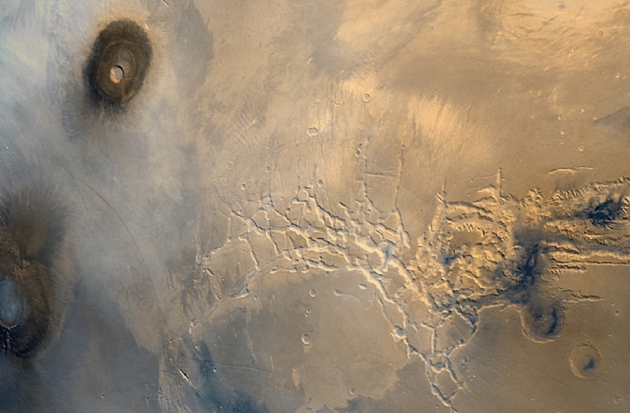
- Noctis Labyrinthus east of the Tharsis region is a large area of “chaotic terrain”. [Credit: Viking/NASA/JPL/USGS
However, there is still no final word on the process creating these features, but water has certainly played a key role in the evolution of the area as shown by the hydrated minerals found in the area (Thollot et al. 2010). Presumably the melting of ice was caused by volcanic activity: Noctis Labyrinthus is adjacent to the Tharsis highlands having many giant volcanoes. An examination of this vast and varied area would yield information on the similar features observed in a smaller scale, like Reull Vallis close to the Hadriaca Patera volcano and several others. In between the flat-topped mesas of Noctis Labyrinthus there are deep depressions formed by outflow of water and collapse of the ground.[Credit: Mars Express/ESA]
In between the flat-topped mesas of Noctis Labyrinthus there are deep depressions formed by outflow of water and collapse of the ground.[Credit: Mars Express/ESA]
Landing a manned mission in Noctis Labyrinthus would offer an opportunity to study the origin and evolution of the chaotic terrain characteristic of the area. It would be a challenge to make a pin-point landing to avoid the hazards of the rough surface. However, in 1969, Apollo 12 landed right on target, less than 200 meters from the Surveyor 3 probe sent to the Moon 2,5 years earlier. Pin-point landings on a distant celestial body are not impossible.
The average depth of Noctis Labyrinthus is about 5 km (Bistachi et al. 2004), so the atmospheric pressure, albeit still very low, would still be above average. Whether the net effect of it would be positive or negative as to the manned mission, is uncertain. Some areas of exploration like meteorology would benefit from the local climate of the valleys – condensate clouds made of water-ice crystals form in this region rather regularly – but this is also an area of dust storm activity.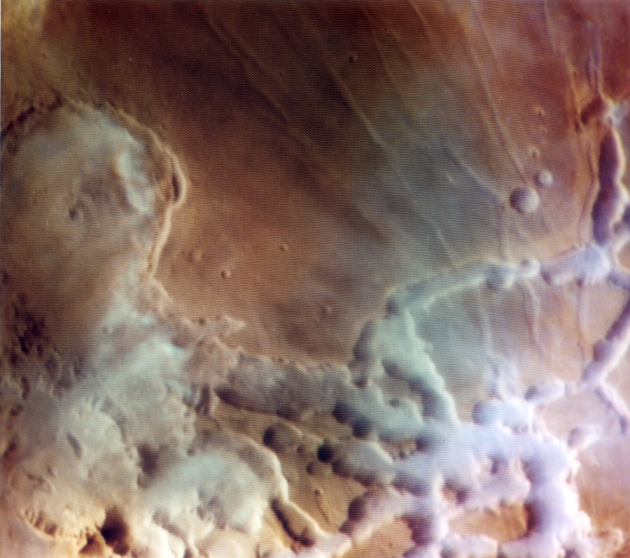
- Early morning water clouds in and around the canyons of Noctis Labyrinthus.[Credit: Viking/USGS/JPL/NASA]
Noctis Labyrinthus could have a definite benefit for a manned mission. There is a possibility for an existence of caves, carved either by the flash floods caused by the sudden melting of subsurface ice, or volcanic flows forming lava tunnels. If existent, they would offer a natural shelter against the ultraviolet radiation of the Sun and the bombardment of the cosmic rays. Otherwise they both would require either a heavily shielded landing craft or a base camp dug beneath the surface. Because of increased mass of the craft these alternatives would make a manned mission more challenging both technically and economically. Noctis Labyrinthus would be interesting also because of its proximity to two extensive surface features with a history still largely unknown: Tharsis and Valles Marineris. The former is evidently of volcanic origin – there are four giant volcanoes on top of Tharsis – and Valles Marineris was formed by rift faults in the crust of Mars, thus being similar to the East African Rift Valley (Hauber et al. 2010), which has later been expanded because of erosion and massive landslides: it is a sign of a kind of “failed” tectonism. It is still unknown whether they are related to each other, and if so, how; and whether either is caused by the other, or are they both caused by some process even more global than either of them.
6. Polar Expedition
Landing on the polar regions would offer an excellent opportunity to explore the enigmatic and simultaneously variable surface features on the high latitudes of Mars. There are theories on how the polar formations like polygons, “spiders”, “forests”, and “swiss cheese”, related to the sublimation of either water or CO2 ice or both, and also larger, but still continuously evolving features like dune fields are formed, but to organize geological field trips to the most interesting of these areas might answer the question of the origin of these formations.
- Geysers of CO2 carrying dust from the subsurface create curious patterns in the polar areas. Credit: MRO/NASA/JPL-Caltech/University of Arizona
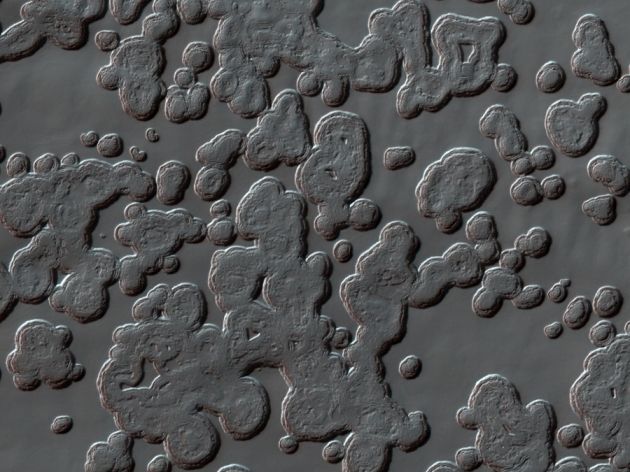
- The cause of “Swiss cheese terrain” found only near the southern polar cap are believed to be the differences in the rate of the seasonal changes of the CO2 and water ices. Credit: NASA/JPL/University of Arizona
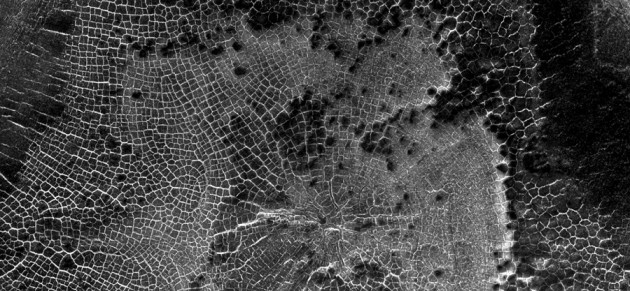
Polygons on the “patterned ground” are reminiscent of the phenomena in the Arctic regions of Earth originating from the changes in the subsurface ice. Credit: NASA/JPL/University of Arizona
The polar regions of Mars are under continuous change. With the seasons the carbon dioxide migrates through the tenuous atmosphere from one pole to the other giving rise to a regular variation in the appearance of the polar caps (Smith et al. 2009). While the southern cap completely disappears during the spring of the southern hemisphere, the residual water ice of the northern one holds through the somewhat colder spring and summer of the northern hemisphere.
The retreating ice is annually leaving behind strange formations the nature and especially the birth processes of which are still largely unknown. The future missions to Mars will – and most probably has to – “live off the land” to the largest possible extent, so landing on or near the polar regions would be a viable option. Water in the form a permafrost is found more or less everywhere on Mars, but on the polar regions, as the Phoenix lander in 2008 proved, it is only few centimeters below the surface thus making it easy to reach and utilize (Smith et al 2009).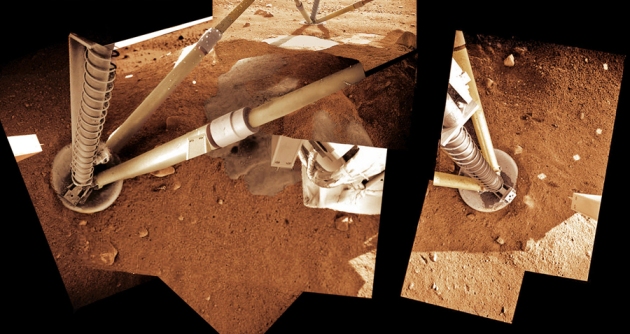
- Phoenix probe landed on water ice covered with only a thin layer of dust and sand. Credit: Kenneth Kramer, Marco Di Lorenzo, NASA/JPL/UA,Max Placnk Institute
However, landing on the polar regions might prove too hazardous because of potential dust storms, landslides, and the CO2 ice covering the ground in winter. To avoid any unnecessary and foreseeable risks it might be more practical to establish a base camp on a safer area, but still within easy reach of the places of interest. This would require reliable and fast enough mode of transportation for the astronauts to be able to explore the area within the time-limit set by the duration of both the stay on the surface of Mars and the changing seasons.
7. Acidalian Mud
A question even more intriguing than the past and present existence of water on Mars – but closely related to it – is the one about life on Mars. Despite promising, yet controversial findings in meteorites originated from Mars (Thomas-Keprta 2009), there are no definite proofs neither for the existence nor non-existence of life.
The surface conditions of present-day Mars are very hostile to life or any organic matter, but in the warmer and wetter past there might have been abodes for life to emerge. Whether the conditions have been favorable for long enough time for life to evolve is another matter of dispute, but if there has been life of any kind, based on the current knowlegde it must have been related with the existence of water. One of the potentially promising areas for finding signs of life is Acidalia Planitia. Along with several other areas on the northern lowlands like Utopia, Isidis, and Chryse Planitia, Acidalia is covered in many places with formations resembling very much the mud volcanoes found on Earth. The latest research implies that the number of these potential mud volcanoes is almost 20 000, perhaps even 40 000 (Oehler and Allen 2010).
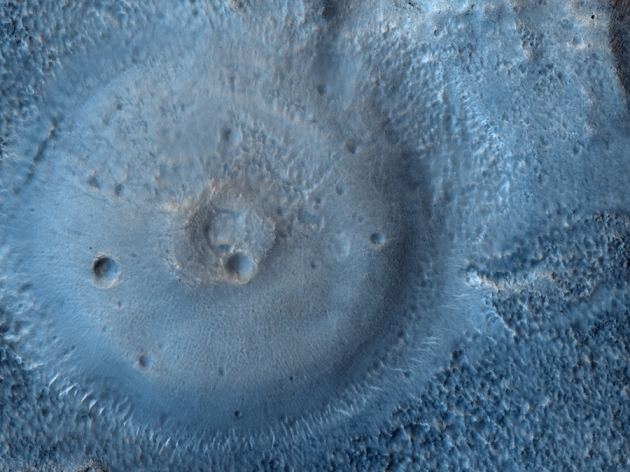
[Image: Possible mud volcanoes found on Mars could give clues to the ancient Martian life – if there was any. Credit: HiRISE/MRO/LPL (U. Arizona)/NASA]
The mud volcanoes are formed by pressurized subsurface gas or liquid erupting to the surface carrying with it material from depths of up the several kilometres. It is possible that there has been – or even today could be – reservoirs of liquid water beneath the thick layer of permafrost; they could have been favorable for bacterial life similar to the extremophiles on Earth. If this is the case, there might still be organic material to be found in the mud and gravel transported to the surface by the eruptions.
Albeit being relatively young, perhaps late Hesperian or early Amazonian, decuded from the fact that they overlap older formations (Tanaka et al. 2005), the mud volcanoes of Acidalia are still two to three billion years old. The strong radiation and surface chemistry would have destroyed any evidence of organic matter, but inside the flat domes with diameters of one kilometre and heights of some 200 metres on average (Oehler and Allen 2010), there might still be some evidence of life to be found. However, reaching it would require, as in the case of the ancient shoreline of the Arctic Ocean, an expedition equipped with drilling machinery.
8. Clays of Mawrth Vallis
One of the oldest valleys on Mars, Mawrth Vallis, could also be potential site for finding signs of ancient Martian life. Recently is has been observed to bear evidence for a prolonged existence of aquatic environment very early in the history of Mars, when the climate of the planet was more temperate, and potentially suitable for life (Poulet et al. 2005).
A stable and long-term presence of large quantities of liquid water is implied by the deposits of hydrated minerals the formation of which requires wet conditions. However, there are different kinds of hydrated minerals, namely phyllosilicates and hydrated sulphates, which have their origins in different kinds of processes. Phyllosilicates, for example clay, are formed by alteration of minerals of magmatic origin having been in contact with water for a considerable length of time. On the other hand, hydrated sulphates are deposits formed from salted water, and their formation requires acidic environment, but not extended periods of contact with water.
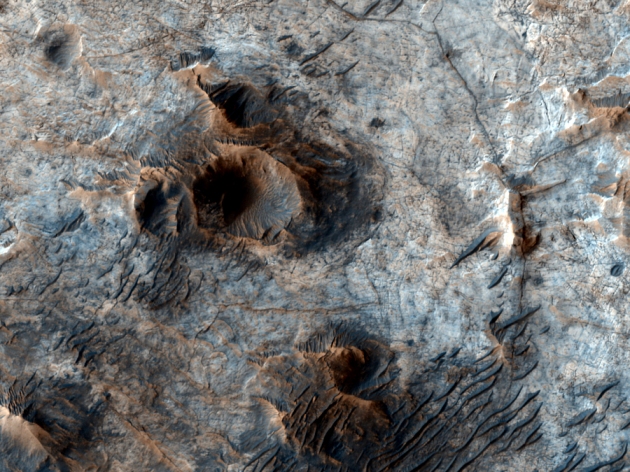
[Image: Mawrth Vallis has Noachian deposits of phyllosilicate minerals with a possibility to find evidence on Martian life. Credit: HiRISE/MRO/LPL (U. Arizona)/NASA]
The detection of phyllosilicates in Mawrth Vallis strongly implies that there has been water on the surface of Mars for extended periods of time in the earliest, the Noachian era, of its evolution, long before the global climate change making Mars a less habitable planet. On Earth the clay minerals are capable of preserving microscopic life, so a thorough examination of the phyllosilicates on Mars could give an answer to the question concerning ancient life on the red planet.
9. Olympus Mons
Another possible landing site for a manned mission with a great potential to capture the imagination of the general public, but not in anyway without scientific benefits would be Olympus Mons, the highest mountain in the Solar System. It could be a key to several questions concerning both the ancient and recent history of Mars.
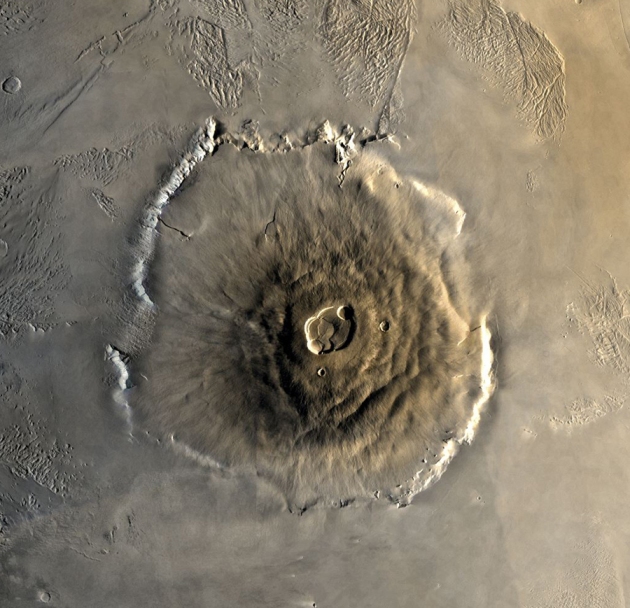 [Image: Olympus Mons, the highest mountain in the Solar System, has possibly been active until rather recently, only few million years ago. Credit: Viking/USGS/JPL/NASA]
[Image: Olympus Mons, the highest mountain in the Solar System, has possibly been active until rather recently, only few million years ago. Credit: Viking/USGS/JPL/NASA]
Olympus Mons is the greatest of the Tharsis volcanoes not only by height, but by the volume of erupted lava and by the time span there has been eruptions. The formation of the mountain is very similar with those on the Hawaiian islands, but because of the lack of plate tectonics on Mars, the volcanic hot spot has been immobile, and the lava has accumulated into just one gigantic mountain.
Based on research made on the aureole surrounding the mountain the origins of Olympus Mons have been dated to the Hesperian era (Fuller and Head 2003), so it is at least 2 billion years old, but there are volcanic flows with an age of just tens of millions, perhaps only few million years (Neukum et al. 2004). In addition to being active until geologically very recently, the volcanic activity has been episodic.
Making detailed studies on the different lava layers on Olympus Mons would enable dating the different stages in the evolution of the mountain with a better accuracy than the current estimates based on crater counts, and trying to find the cause for the periodical behaviour – and possibly for the formation of the Tharsis region as a whole.
Olympus Mons is often shrouded with CO2 ice clouds making it an ideal site also for meteorological observations. The nature of the clouds – composition, density, temperature – could be measured readily with a possibility to take samples of the ice crystals making up the clouds. The size of the mountain is such, that it has a major effect on the air currents and wind patterns in the atmosphere of Mars, and consequently on the Martian weather (Wolkenberg 2008). To make direct observations on the spot of origin of these effects would help develop more detailed models for both global and local weather phenomena.
All this could be done with robotic probes, but Olympus Mons might offer an extra benefit for a future base camp. The slopes of the mountain could hide a number of caves formed by collapsed lava tunnels. Just like in the case of Noctic Labyrinthus these would offer a natural shelter against the harsh radiation environment on the surface of Mars. The great height of Olympus Mons would also keep a base camp well above all but the largest, global dust storms.
A mountain with a summit rising 25 kilometres higher than the surrounding landscape might appear as an extremely challenging site for any, especially manned, mission and the activities related with it. In reality the slopes of the mountain – apart from the steep cliffs especially on the eastern flank of the mountain – are very gentle, with a gradient of only few degrees. Together with the low gravity of Mars of some 40 % that of Earth this would result in an easy traversing on Olympus Mons, not so much going uphill or downhill, but only walking or driving around.
The obvious downside of Olympus Mons as a potential landing site for a manned mission is the very probable lack of subsurface ice to be exploited by the expedition. If there were any ice, it would be very deep in the ground and practically unattainable without very heavy machinery.
10. Selecting the Target
Making the selection between various options for the landing site of a manned mission to Mars aimed at exploring the surface anomalies will not be a simple task. The arguments to be taken into account include both the safety and practicality of the mission, and the possibility to make in-situ studies with scientific results increasing our knowledge on the anomalies specifically and on the evolution of Mars in general. However, trying to meet these criteria is an effort worth making.
There are many reasons why future manned missions to Mars must include among their primary objectives the exploration and examination of these surface anomalies: to explore their true nature, to solve their origin, to find out their importance in the geologic evolution of the planet, and – not the least important of the reasons – to feed the imagination of general public and keep up public interest in continued exploration of our planetary neighbor.
[Credit: Journal of Cosmology]





















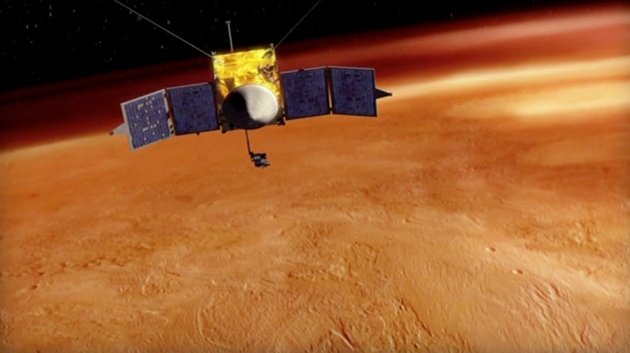



 2. Those arguments should have been satisfied with the cited data. If not, additional evidence added an even richer context in support of the LR results. Main items are listed as follows.
2. Those arguments should have been satisfied with the cited data. If not, additional evidence added an even richer context in support of the LR results. Main items are listed as follows. After exploration , we need to search the base where we will reside on. Then we can even think about terraforming Mars.If a viable Martian civilization can be established, its population and powers to change its planet will continue to grow. The advantages accruing to such a society of terraforming Mars into a more human-friendly environment are manifest4. Put simply, if enough people find a way to live and prosper on Mars there is no doubt but that sooner or later they will terraform the planet. The feasibility or lack thereof of terraforming Mars is thus in a sense a corollary to the economic viability of the Martian colonization effort. Green House gases would be best to increase temperature significantly. In a research it was shown that a rate of halocarbon production of about 1000 tonnes per hour would directly induce a temperature rise of about 10 K on Mars, and that the outgassing of CO2 caused by this direct forcing would likely raise the average temperature on Mars by 40 to 50 K, resulting in a Mars with a surface pressure over 200 mbar and seasonal incidence of liquid water in the warmest parts of the planet. Production of halocarbons at this rate would require an industrial establishment on Mars wielding about 5000 MW or power supported by a division of labor requiring at least (assuming optimistic application of robotics) 10,000 people. Such an operation would be enormous compared to our current space efforts, but very small compared to the overall human economic effort even at present. It is therefore anticipated that such efforts could commence as early as the mid 21st Century, with a substantial amount of the outgassing following on a time scale of a few decades. While humans could not breath the atmosphere of such a Mars, plants could, and under such conditions increasingly complex types of pioneering vegetation could be disseminated to create soil, oxygen, and ultimately the foundation for a thriving ecosphere on Mars. The presence of substantial pressure, even of an unbreathable atmosphere, would greatly benefit human settlers as only simple breathing gear and warm clothes (i.e. no spacesuits) would be required to operate in the open, and city-sized inflatable structures could be erected (since there would be no pressure differential with the outside world) that could house very large settlements in an open-air shirt-sleeve environment.
After exploration , we need to search the base where we will reside on. Then we can even think about terraforming Mars.If a viable Martian civilization can be established, its population and powers to change its planet will continue to grow. The advantages accruing to such a society of terraforming Mars into a more human-friendly environment are manifest4. Put simply, if enough people find a way to live and prosper on Mars there is no doubt but that sooner or later they will terraform the planet. The feasibility or lack thereof of terraforming Mars is thus in a sense a corollary to the economic viability of the Martian colonization effort. Green House gases would be best to increase temperature significantly. In a research it was shown that a rate of halocarbon production of about 1000 tonnes per hour would directly induce a temperature rise of about 10 K on Mars, and that the outgassing of CO2 caused by this direct forcing would likely raise the average temperature on Mars by 40 to 50 K, resulting in a Mars with a surface pressure over 200 mbar and seasonal incidence of liquid water in the warmest parts of the planet. Production of halocarbons at this rate would require an industrial establishment on Mars wielding about 5000 MW or power supported by a division of labor requiring at least (assuming optimistic application of robotics) 10,000 people. Such an operation would be enormous compared to our current space efforts, but very small compared to the overall human economic effort even at present. It is therefore anticipated that such efforts could commence as early as the mid 21st Century, with a substantial amount of the outgassing following on a time scale of a few decades. While humans could not breath the atmosphere of such a Mars, plants could, and under such conditions increasingly complex types of pioneering vegetation could be disseminated to create soil, oxygen, and ultimately the foundation for a thriving ecosphere on Mars. The presence of substantial pressure, even of an unbreathable atmosphere, would greatly benefit human settlers as only simple breathing gear and warm clothes (i.e. no spacesuits) would be required to operate in the open, and city-sized inflatable structures could be erected (since there would be no pressure differential with the outside world) that could house very large settlements in an open-air shirt-sleeve environment.
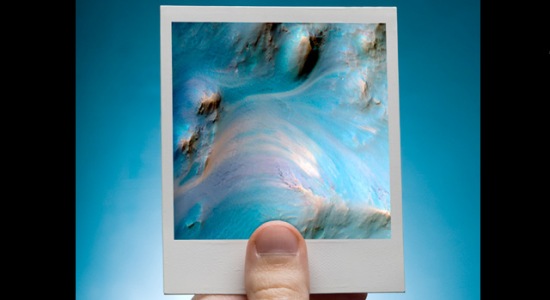 The most powerful camera aboard a NASA spacecraft orbiting Mars will soon be taking photo suggestions from the public.
The most powerful camera aboard a NASA spacecraft orbiting Mars will soon be taking photo suggestions from the public.





